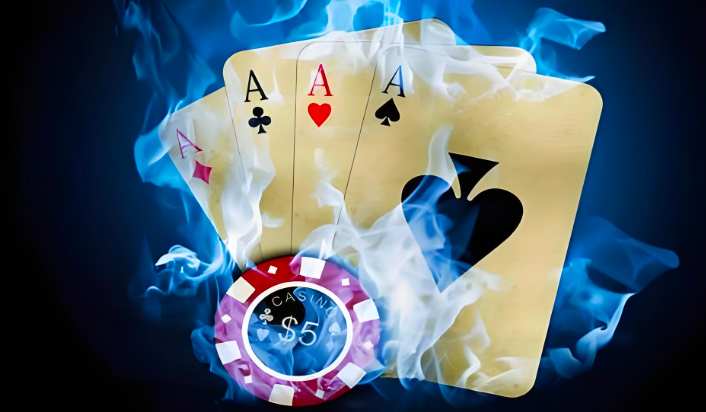Learning the basic rules of Texas Hold'em, understanding the quality of some hands, and comparing the size of the final showdown are relatively easy parts that only take a few minutes to master.
To truly master the various playing methods of Texas Hold'em and turn it into a tool for sustained profitability requires a lot of practical experience and a long time accumulation.
For new players just starting out, it's important to strike a balance between the fun, excitement, and substantial losses associated with playing Texas Hold'em. If you don't know what you're doing, you could suffer significant losses. So how can you become the next Texas Hold'em master? Here are five poker game strategy tips to help you.

More aggressive than usual
The only way to win in Texas Hold'em is to bet, and the way to win big is to bet big. Texas Hold'em is a game of focused attack at a fixed time. After mastering the basic knowledge of the game, you will know when to increase your aggression on the table.
Many novice players are too cautious and passive most of the time. They will choose to check when they should bet and call when they should raise. When you have a good hand, such as high pairs (AA, KK, QQ, etc.) or AK, AQ, your play should be more aggressive.
These are all good starting hands, so make sure to play the weaker players out of the game or force them to pay a higher price to stay in the game. The worst case scenario is that KK passes the cards before the flop, but is miraculously defeated by the player holding hand 84 who draws a straight. You should make the weaker players pay a certain price before looking at the cards and push most of the players out of the pot as soon as possible. You should know that when there are six players in the pot, your basic winning probability is only 17%, even if your hand is AA, your winning probability in a six-player pot will not be too high. When there are only two players in the pot, your basic winning probability rises to 50%, and if you hold AA at this time, your winning probability will rise to over 76%.
The worst thing about playing cautiously is that it will make you a “weak player” in the minds of other players at the table. If you rarely bet or raise, you will soon find that strong players who know that you will fold under pressure will constantly squeeze you. When you place a large bet, other players will immediately know that you have a strong hand, and everyone will quickly fold, minimizing the amount you can win.
Remember that aggressive play is the key to building a large pot. If you have a winning hand, the best move is to squeeze every possible reward from the table. This is also the most fun and thrilling part of Texas Hold'em.
Secondly, one must possess patience
Aggressive play does not mean making random bets on poor hands, or even betting all your chips on the hope of winning big cards during the river. This kind of play will quickly reduce your chips. “Aggressive” play is the most common profitable method in Texas Hold'em. A large number of professional players use strong self-discipline to strictly control the range of hands they enter the pot before the flop, and skillfully apply aggressive play after the flop. They play “aggressive” style with great proficiency.
One of the most basic skills in Texas Hold'em is to fold far more often than you play. For many players, this sounds like a very boring way to play the game, where you can only sit at the table and watch while everyone else is playing.
Sometimes, a large number of pre-flop folds can make you feel “burned” and cause you to lose a lot, but using poor quality hands to force your way into the pot and rely on luck can make you lose even more in the long run. The correct approach is to wait for the right hand, enter the pot and increase the pot size. Although good hands do not guarantee 100% victory, from a long-term perspective, this is a profitable strategy.
Remember, this is simply based on the Law of Averages: the majority of hands played will be losing hands (i.e. at a 9-player table, there are 9 hands dealt, and only 1 person can win). If you don't have a strong hand, the best move is to fold and immediately fold.
Use this time to observe other players at your table and study their strategies. When you don't have to worry about your own hand, you can focus more on observing all other players.
The most important thing is to wait patiently for the odds to be in your favor, then use your aggressiveness to build a large pot, and ultimately win.
Third, pay attention to observing the opponent
There is a saying in Texas Hold'em: Play the player, not your cards. Simply put, Texas Hold'em requires judging the situation and adapting to different players.
Typically, the quality of your hand is relative and entirely depends on the quality of the other players' hands. KK is a fantastic hand, but if your opponent holds AA, then your KK will only have a 18% winning rate in a single-handed game. Imagine another situation: you hold AJ and the other player holds QQ. When the flop comes up J-8-6, your top pair J only has a 20% winning rate.
How can you know what cards other players have? By observing other players and studying their playing styles. Suppose the above J-8-6 flop situation, and your hand is AA, what would you do?
Have you ever seen this player play slow when holding a big hand? For example, he only checks or calls instead of betting or raising. If he plays slow, you must be cautious with this AA hand and try to control the pot as much as possible without building a large pot.
When a “wet” card appears on the board, have you ever seen him bluff with a large bet in an attempt to collect the pot? If so, you should probably call his bet or even raise it. You should know that sets like JJ or 88 and 66 are very rare cards, and your AA is usually ahead of him in most situations.
In addition to studying the opponent's playing style, you also need to observe their weaknesses or tells. Tells usually refer to the habitual actions that players subconsciously reveal, which reveal their hand information and psychological activities to a certain extent. Tells are not just the nervous habits seen in movies, such as fiddling with chips, eating cookies, or rubbing rings, but also include the way a person plays cards. For example, if someone has been making bets all night but suddenly raises a large amount of money, it may be because they have the highest card (nuts).
Consider the “long-term”
As a beginner player, you will lose. However, when you improve your skills and become an “expert”, at some point, even if you don't make mistakes in your play, you will still lose. For example, in a hand where you hold AA and preflop all in, you lose to another player who holds 88 because the third 8 on the river makes him a three-of-a-kind. Although your winning percentage for this hand is 80%, there are still small probability events that happen, which are commonly known as BB (bad beat).
Don't let these types of losses affect you. Although AA can't always beat 88, in the long run, 80% is much higher than 20%. This is definitely a highly profitable investment.
The following example can be used to understand the win rate, odds, and profitability. AA and 88 turn over all in before the game starts, with two players each having 500 chips and a total pot of 1000. In an ideal situation, the AA player with a 80% win rate should receive 80% of the 1000 pot, which can be understood as investing 500 and receiving 800 returns, with a profit of 300. However, there is no such “20-80 split” in Texas Hold'em. In most cases, we see that AA wins and collects the 1000 pot, which is a profit of 500.
The extra 200 points here are actually due to AA's “good luck”, as 20% of the events did not occur. Of course, there are times of “bad luck” as well as “good luck”. AA loses to 88 on average five times, so there is no need to be particularly angry or frustrated about a single bad luck. Texas Hold'em is a long-term game, and good luck can lead to a profit one time, but good skills can lead to consistent profits. This is the essence and charm of Texas Hold'em.
Learning how to win in Texas Hold'em is a long-term project that requires playing thousands of hands in a real-life environment. Only in this way can one firmly grasp the basic essentials, and becoming a professional player will require even more effort.
When using this article from the German Poker Base to guide yourself in developing skills, keep in mind the first three tips: be aggressive when necessary, play patiently and cautiously, and study your opponents and the game like a beloved movie. This will keep your gameplay within control, resist the urge to “get carried away”, and not try to make up for losses by making foolish bets. Set a budget for each stage and long-term, and stick to it.



